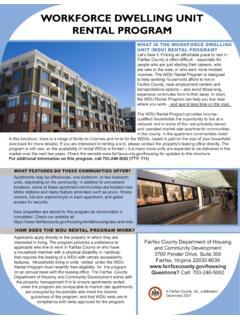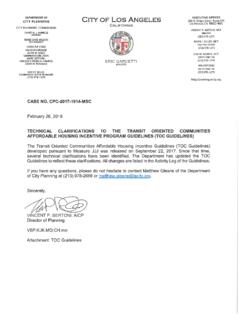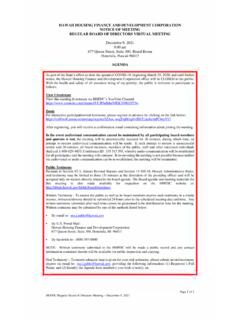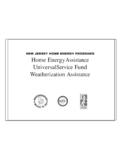Transcription of 4350.1 REV-1 CHAPTER 4. RESERVE FUND FOR …
1 REV-1 _____ CHAPTER 4. RESERVE FUND FOR REPLACEMENTS 4-1 Introduction and Applicability. A RESERVE Fund for Replacements exists for most projects with HUD-insured, formerly coinsured, and HUD-held mortgages. This CHAPTER applies to these projects as well as to Section 202 and Section 162 Direct Loan Program projects and Section 801 and 811 Capital Advance Program projects. The RESERVE Fund is generally used to help defray the costs of replacing a project's capital items. Title 24 of the Code of Federal Regulations provides, at Section (f)(3)(i), "In all projects, except those involving rehabilitation where the mortgage does not exceed $200,000, a fund for replacements shall be established and maintained with the mortgagee.
2 The amount and type of such fund and the conditions under which it shall be accumulated, replenished, and used, shall be specified in the charter, trust agreement, or regulatory agreement." 4-2 Regulatory Agreements for projects generally contain the following typical language pertaining to the RESERVE Fund for Replacements to the effect that owners shall establish or continue to maintain a RESERVE fund for replacements by the allocation to such RESERVE fund in a separate account with the mortgagee or in a safe and responsible depository designated by the mortgagee, concurrently with the beginning of payments towards amortization of principal of the mortgage insured or held by the Federal Housing Commissioner of an amount equal to $_____ per month unless a different date or amount is approved in writing by the Commissioner.
3 Such fund, whether in the form of a cash deposit or invested in obligations of, or fully guaranteed as to principal by, the United States of America shall at all times be under the control of the mortgagee. Disbursements from such fund, whether for the purpose of effecting replacement of structural elements and mechanical equipment of the project, for the cure of mortgage defaults, or for any other purpose, may be made only after receiving the consent in writing of the Commissioner. In the case of Section 202, 162, 801, or 811 projects, where HUD serves as the mortgagee, the project owner escrows the funds but may not withdraw them from the RESERVE for Replacements Account without the Asset Management Branch Chief's written permission. For HUD-Held mortgages, HUD shall exercise control over the RESERVE Fund for Replacements by acting pursuant to its own authority as well as in the stead of the mortgagee.
4 This authority may be exercised only by HUD Headquarters. _____ 4-1 3/95 _____ REV-1 _____ 4-3 Mortgagee's Certificates generally contain the following typical language that pertains to the RESERVE Fund for Replacements: "Beginning on the date on which the first payment toward amortization is required to be made by the terms of the insured mortgage or at such later date as may be agreed to by you [the Federal Housing Commissioner], we [the Mortgagee] shall require a monthly deposit with us or in a depository satisfactory to us of one-twelfth (1/12) of the sum set forth in your Commitment for Insurance constituting a ' RESERVE Fund for Replacements' which fund shall be subject to our order and from which fund withdrawals may be made only upon the receipt of your written permission.
5 These funds will be deposited with us by the Mortgagor in cash or in the form of obligations of or guaranteed as to principal by the United States of America. We will, upon appropriate request by the Mortgagor, permit the conversion of the whole or a substantial part of such cash deposits into the form of obligations of, or fully guaranteed as to principal by, the United States of America.." 4-4 Remaining Economic Life of Building Improvements. Economic life is the period over which improvements to real property contribute to property value. Because buildings are subject to physical deterioration and functional or economic obsolescence, their periods of usefulness are limited. For purposes of this CHAPTER 4, "buildings" includes building structures themselves, major movable equipment, and other on-site improvements such as water mains, sewer laterals, swimming pools, parking lots, etc.
6 As buildings deteriorate or become obsolete, their ability to serve useful purposes decreases and eventually disappears. This decline and ultimate disappearance of utility may occur gradually or rapidly. _____ 3/95 4-2 _____ REV-1 _____ 4-5 Economic Life vs. Physical Life. The period between the time of completion of the building and the time when it is no longer fit or safe for use, or when it is no longer practicable to maintain it in a safe and usable condition, is its total physical life. The total economic life of a structure is the period of time between the completion of the building and the disappearance of its ability to produce the service of providing housing for its intended occupants (in the case of non-profit mortgagors) or net returns over and above a return on the land value (in the case of profit motivated and limited dividend mortgagors), notwithstanding that it is structurally sound, in good condition, and usable (though not functionally or profitably).
7 A. Estimates are made of both physical life and remaining economic life, but the estimate of physical life sets the maximum for the estimate of economic life. NOTE: Judicious use of the RESERVE Fund for Replacements is expected to extend the physical life of the building. B. Economic life can never be greater than physical life but it may be and frequently is less. A structure may be sound and in good physical condition with a number of years of physical life remaining and yet have reached the end of its economic life if its remaining years of physical usefulness will not deliver a positive cash flow or provide the service of supplying housing on a cost-effective basis. 4-6 Estimates of Remaining Economic Life. In predicting the remaining economic life of a building, six types of factors are considered: A. Economic background of the community or region and the need for accommodations of the type represented.
8 B. Relationship between the property and the immediate environment. C. Architectural design, style, and utility from the functional point of view and the likelihood of obsolescence attributable to new inventions, new materials, changes in building codes, and changes in tastes. D. Trend and rate of changes of characteristics of the neighborhood and their effect upon land values. _____ 4-3 9/92 _____ REV-1 _____ E. Workmanship and durability of construction and the rapidity with which natural forces cause physical deterioration. F. Physical condition and probable cost of maintenance and repair, the practices of owners and occupants with respect to maintenance, and the use or abuse to which structures are subjected. 4-7 End of Useful Life of Building Improvements. The useful life of a building has come to an end when the building is incapable of producing an annual income sufficient to offset the expense of operation and maintenance, insurance, and taxes, and to produce returns upon the value of the land or provide the service of shelter for the intended occupants in the case of non-profit owners.
9 The improvements upon the land at that time possess no more value than the amount which can be obtained from a purchaser who will buy them and remove them from the site. At this point the value of the building has dwindled to "Shell" value less demolition costs. The last years of economic life are more difficult to predict than the first years, so caution must be exercised to avoid over-estimation of the remaining economic life for older buildings in older, declining neighborhoods. 4-8 Many projects with HUD-insured or HUD-held mortgages were underwritten with forty year mortgages and with estimated economic lives of fifty-five years. The RESERVE Fund for Replacements was established to help ensure that the physical live of the buildings and structures would extend to the assumed 55-year economic lives. It was not the original purpose of this RESERVE Fund to provide for a complete, dollar for dollar, capability of replacing all the building structural components and equipment as these wear out but rather to provide a readily available source of capital that will help defray these costs in the latter years of amortization of the mortgage note.
10 _____ 9/92 4-4 _____ REV-1 _____ 4-9 Building components generally tend to fall into two categories: 1. Those items that are usually considered to be capital items and eligible for reimbursement from the RESERVE Fund for Replacements to the extent of the availability of money in that account; and, 2. Those items that are usually considered to be routine maintenance items. As a guideline, repair/replacement expenditures that are generally capitalized may often be eligible for payment from a project's RESERVE Fund, while those expenditures that are expensed are only occasionally eligible for payment from the RESERVE Fund. NOTE: As items, equipment, etc. that fall into either of these classifications are obtained for a project, HUD expects that mortgagors will be mindful of energy and environmental considerations and will be sensitive to issues involving handicapped/disabled persons.















